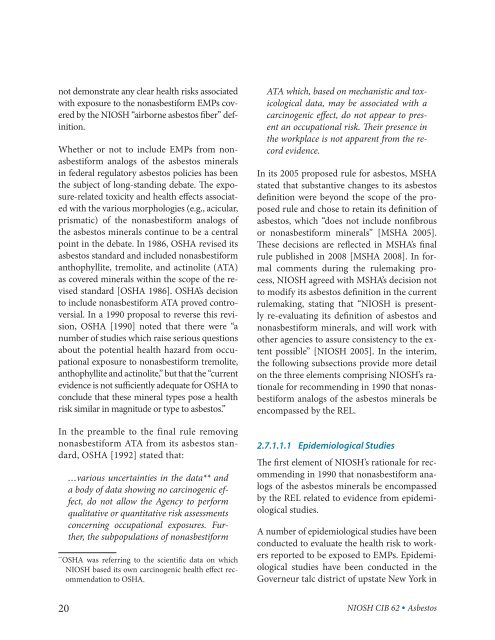Asbestos Fibers and Other Elongate Mineral Particles: State of the ...
Asbestos Fibers and Other Elongate Mineral Particles: State of the ...
Asbestos Fibers and Other Elongate Mineral Particles: State of the ...
- No tags were found...
Create successful ePaper yourself
Turn your PDF publications into a flip-book with our unique Google optimized e-Paper software.
not demonstrate any clear health risks associated<br />
with exposure to <strong>the</strong> nonasbestiform EMPs covered<br />
by <strong>the</strong> NIOSH “airborne asbestos fiber” definition.<br />
Whe<strong>the</strong>r or not to include EMPs from nonasbesti<br />
form analogs <strong>of</strong> <strong>the</strong> asbestos minerals<br />
in federal regulatory asbestos policies has been<br />
<strong>the</strong> subject <strong>of</strong> long-st<strong>and</strong>ing debate. The exposure-related<br />
toxicity <strong>and</strong> health effects associated<br />
with <strong>the</strong> various morphologies (e.g., acicular,<br />
prismatic) <strong>of</strong> <strong>the</strong> nonasbestiform analogs <strong>of</strong><br />
<strong>the</strong> asbestos minerals continue to be a central<br />
point in <strong>the</strong> debate. In 1986, OSHA revised its<br />
asbestos st<strong>and</strong>ard <strong>and</strong> included nonasbestiform<br />
anthophyllite, tremolite, <strong>and</strong> actinolite (ATA)<br />
as covered minerals within <strong>the</strong> scope <strong>of</strong> <strong>the</strong> revised<br />
st<strong>and</strong>ard [OSHA 1986]. OSHA’s decision<br />
to include nonasbestiform ATA proved controversial.<br />
In a 1990 proposal to reverse this revision,<br />
OSHA [1990] noted that <strong>the</strong>re were “a<br />
number <strong>of</strong> studies which raise serious questions<br />
about <strong>the</strong> potential health hazard from occupational<br />
exposure to nonasbestiform tremolite,<br />
anthophyllite <strong>and</strong> actinolite,” but that <strong>the</strong> “current<br />
evidence is not sufficiently adequate for OSHA to<br />
conclude that <strong>the</strong>se mineral types pose a health<br />
risk similar in magnitude or type to asbestos.”<br />
In <strong>the</strong> preamble to <strong>the</strong> final rule removing<br />
nonasbestiform ATA from its asbestos st<strong>and</strong>ard,<br />
OSHA [1992] stated that:<br />
20<br />
…various uncertainties in <strong>the</strong> data** <strong>and</strong><br />
a body <strong>of</strong> data showing no carcinogenic effect,<br />
do not allow <strong>the</strong> Agency to perform<br />
qualitative or quantitative risk assessments<br />
concerning occupational exposures. Fur<strong>the</strong>r,<br />
<strong>the</strong> subpopulations <strong>of</strong> nonasbestiform<br />
** OSHA was referring to <strong>the</strong> scientific data on which<br />
NIOSH based its own carcinogenic health effect recommendation<br />
to OSHA.<br />
ATA which, based on mechanistic <strong>and</strong> toxicological<br />
data, may be associated with a<br />
carcinogenic effect, do not appear to present<br />
an occupational risk. Their presence in<br />
<strong>the</strong> workplace is not apparent from <strong>the</strong> record<br />
evidence.<br />
In its 2005 proposed rule for asbestos, MSHA<br />
stated that substantive changes to its asbestos<br />
definition were beyond <strong>the</strong> scope <strong>of</strong> <strong>the</strong> proposed<br />
rule <strong>and</strong> chose to retain its definition <strong>of</strong><br />
asbestos, which “does not include nonfibrous<br />
or nonasbestiform minerals” [MSHA 2005].<br />
These decisions are reflected in MSHA’s final<br />
rule published in 2008 [MSHA 2008]. In formal<br />
comments during <strong>the</strong> rulemaking process,<br />
NIOSH agreed with MSHA’s decision not<br />
to modify its asbestos definition in <strong>the</strong> current<br />
rulemaking, stating that “NIOSH is presently<br />
re-evaluating its definition <strong>of</strong> asbestos <strong>and</strong><br />
nonasbestiform minerals, <strong>and</strong> will work with<br />
o<strong>the</strong>r agencies to assure consistency to <strong>the</strong> extent<br />
possible” [NIOSH 2005]. In <strong>the</strong> interim,<br />
<strong>the</strong> following subsections provide more detail<br />
on <strong>the</strong> three elements comprising NIOSH’s rationale<br />
for recommending in 1990 that nonasbestiform<br />
analogs <strong>of</strong> <strong>the</strong> asbestos minerals be<br />
encompassed by <strong>the</strong> REL.<br />
2.7.1.1.1 Epidemiological Studies<br />
The first element <strong>of</strong> NIOSH’s rationale for recommending<br />
in 1990 that nonasbestiform analogs<br />
<strong>of</strong> <strong>the</strong> asbestos minerals be encompassed<br />
by <strong>the</strong> REL related to evidence from epidemiological<br />
studies.<br />
A number <strong>of</strong> epidemiological studies have been<br />
conducted to evaluate <strong>the</strong> health risk to workers<br />
reported to be exposed to EMPs. Epidemiological<br />
studies have been conducted in <strong>the</strong><br />
Governeur talc district <strong>of</strong> upstate New York in<br />
NIOSH CIB 62 • <strong>Asbestos</strong>

















